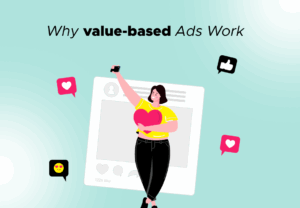The power of value-driven advertising and why it converts
Discover how value-driven advertising drives 79% higher conversions by aligning with demographic values. See the complete guide to target Gen Z, Millennials, Gen X, and Boomers effectively.
October 25, 2025

Value-based marketing is revolutionizing how brands connect with consumers by moving beyond traditional product features to tap into what audiences truly care about. Research shows that 79% of consumers are more likely to purchase from brands whose values mirror their own, making this approach essential for modern marketing success.
Understanding value-driven advertising
Value-driven advertising aligns brand messaging with customer beliefs, creating authentic emotional connections that drive conversions. Unlike traditional marketing focused on features and pricing, this approach taps into four core value types: functional value (time-saving solutions), economic value (long-term ROI), psychological value (emotional connection and identity), and social value (sustainability and social responsibility).
The data supporting this shift is compelling. Purpose-led brands have experienced 175% valuation growth over 12 years compared to just 70% for brands without clear values. Additionally, 64% of marketing executives consider data-driven marketing indispensable as the Big Data Analytics Market approaches $650 billion by 2029.
The demographic divide: tailoring messages by generation
The key to successful value-driven advertising lies in understanding that different generations prioritize vastly different values. What resonates with Gen Z will fall flat with Baby Boomers, and vice versa.
Gen Z: authenticity and activism (ages 13-28, $450 billion+ spending power)
Shopping behavior:
- 80% shop online, 80% discover products via social media
- Read 3+ reviews before purchasing
- 82% more influenced by social media than traditional ads
- 60% will pay premium for sustainable products
Core values:
- Demand public stances on racial justice, LGBTQ+ rights, climate change
- Actively call out greenwashing on social media
- Expect radical transparency and ethical sourcing
- Value micro-influencer authenticity over celebrity endorsements
Marketing strategy:
- Treat TikTok and Instagram as search engines
- Optimize video titles, descriptions, hashtags
- Emphasize genuine sustainability, not surface-level green marketing
- Partner with micro-influencers for authentic messaging
Millennials: purpose meets practicality (ages 29-44, $3-4 trillion spending power)
Shopping behavior:
- Represent 25%+ of total consumer spending
- 75% prefer online shopping, 65% research on social media
- 43% bought through in-app shops, 36% via influencer recommendations
- 83% favor brands aligning with values
Core values:
- Work-life balance and personal development
- Social causes: income inequality, healthcare access
- Authentic commitments (detect performative activism instantly)
- Practical solutions that simplify busy lives
Marketing strategy:
- Email marketing automation and personalization
- Long-form content proving measurable social impact
- LinkedIn for B2B, Instagram for B2C
- Authenticity over polish
Gen X: quality and independence (ages 45-60, $4-5 billion spending power)
Shopping behavior:
- 34% of consumer spending with steady market share
- 65% shop online, 45% use social media for research
- Value search engines and detailed product reviews
- 42% more willing to pay for sustainable products
Core values:
- Quality, reliability, transparent communication
- Product longevity and ethical business practices
- Independence and self-reliance
- Reject overly political or performative messaging
Marketing strategy:
- Long-tail SEO keywords and Google search optimization
- Detailed product reviews and comparison content
- Facebook advertising
- Straightforward value propositions backed by evidence
Baby Boomers: reliability and service (ages 61-79, $5-6 trillion spending power)
Shopping behavior:
- Largest total spending power of any generation
- 55% shop online (rapidly growing), 25% use social media
- Respond to TV, print, direct mail, paid search
- 50% prefer brands avoid political/social stances
Core values:
- Reliability, heritage, exceptional customer service
- Functional and economic value over social positioning
- Product quality and company heritage
- Practical benefits over activism
Marketing strategy:
- Google Ads with exact match keywords
- Customer testimonials and proven track records
- Traditional advertising formats (TV, print, direct mail)
- Focus on reliability and clear value propositions
Implementing value-driven campaigns: key strategies
Successful value-driven advertising requires matching your message to your target demographic’s priorities. Research your audience thoroughly using analytics tools to identify high-volume, low-competition keywords relevant to each generation.
Create detailed buyer personas that go beyond demographics to understand functional, economic, psychological, and social value priorities. Map the customer journey from awareness to conversion, recognizing that Gen Z discovers through TikTok while Boomers respond to Google search ads.
Content strategy must adapt to platform and audience. Video content dominates younger demographics (44% prefer short videos for product discovery), while older generations value detailed written reviews. Platform-specific optimization matters – Instagram requires keyword-rich captions and alt text, LinkedIn demands professionally-focused long-form articles, and Facebook allows detailed demographic targeting.
Track ROI across all channels, monitoring both keyword rankings and engagement metrics. A/B test value-driven messaging to understand what resonates with each demographic segment. The most successful campaigns combine organic social media marketing with paid advertising, influencer partnerships for younger audiences, and traditional channels for older demographics.
The convergence of values and data
The future of advertising lies in the intersection of authentic values and sophisticated data analytics. Social media platforms now function as search engines, with 5.41 billion global users spending an average 151 minutes daily on these platforms. Social media advertising will reach $255.8 billion by 2028 in mobile advertising alone.
Emerging trends include AI-powered content creation, video dominance across platforms, social commerce integration, and strategic micro-influencer partnerships offering higher ROI than celebrity endorsements. Privacy-focused marketing becomes increasingly important in the post-cookie era.
The most successful brands aren’t just selling products – they’re standing for something meaningful to their specific audience. Gen Z demands activism and transparency. Millennials want authentic purpose paired with practical solutions. Gen X seeks quality and independence. Boomers prioritize reliability and service. Understanding these differences transforms advertising from interruption to connection, creating loyal customers rather than one-time buyers.
Latest News ☕

Golden Globes 2026: One battle after another dominates amid social media snubs
December 9, 2025
Paul Thomas Anderson's One battle after another swept the 2026 Golden Globe nominations wi...

Social engagement in 2025, top platforms & the brands millennials still love
December 4, 2025
Think millennials checked out of social media? Think again. In 2025, they were more engage...

Social media drives Black Friday sales: The first stats are in
December 1, 2025
Black Friday 2025 marks social commerce's breakthrough moment. With sales up 54.5% and hou...


